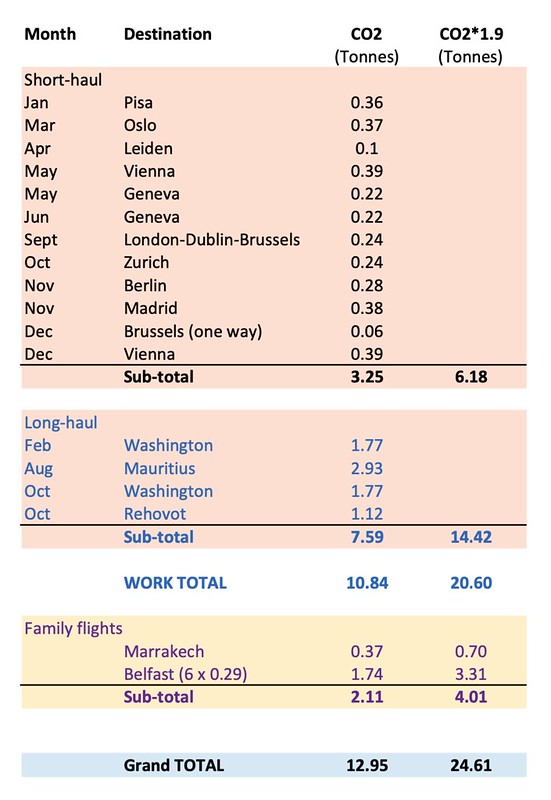What was your carbon footprint for 2019? Mine was more of a bootprint, almost entirely because of flying.
International travel has long been considered one of the perks of academic life, something that lifted the job out of the ordinary and cemented our membership of a trans-national community of scientists and scholars. Over the years I have travelled to Grenoble and Hamburg for experiments, to Tokyo and Honolulu for meetings with collaborators, and to places like Beijing, Santiago (in Chile) and New York for scientific conferences.
For much of that time, though I may have travelled far, the trips were relatively infrequent. Some years, particularly early in my research career, I did not venture beyond these shores. Now that I have clocked up a few more years and moved into management and policy work, I have also been clocking up the air-miles.
2019 was my worst year yet. By my count, I gave at least 26 invited talks over the last twelve months, 16 of them outside the UK. I travelled abroad on five further occasions on university business and to attend grant panel and advisory board meetings. I also flew to Ireland six times to visit my elderly parents, and my wife and I treated ourselves to a trip to Marrakech at Easter. As well as keeping count of the number of journeys, I was moved this year to tot up the amount of carbon dioxide added to the atmosphere by my travels. The results are pretty shocking.
There are a variety of online tools with to help you work out the impact of your air miles, which (from my limited testing) give similar results. More or less at random I used the calculator at www.carbonfootprint.com, and got the results below.
These numbers are a bit squishy because there are factors that are tricky to take into account. For example, long-haul is ‘better’ than short-haul, because taxiing and take-off use proportionately more energy; and newer planes are more energy-efficient. The tally also depends on how many of the seats on the plane are occupied and where you are sitting: fuller planes and economy seats that take up less room are less damaging to the environment per passenger mile. You can also choose in this calculator (as I have done) to take account of radiative forcing, the increased effect on global warming of carbon emissions at high altitude – which increases your total by a factor of about 1.9.
Even so, I will assume that the resulting tally is reasonably robust and mine is very large. By flying for work I effectively added 20.6 tonnes of CO2 into the atmosphere and a further 4.0 tonnes because of family visits and that trip to Marrakech, making a grand total of 24.6 tonnes. That compares to the annual total for each UK citizen (averaged over all domestic, industrial and commercial activities, including transport) of about 5.6 tonnes. That number is 8.6 for the average EU citizen, 16.1 in the USA, 2.4 in Brazil, 1.9 in Morocco and 0.6 in Nigeria (see Wikipedia for the full list).
Globally, transport accounts for about 22% of carbon dioxide emissions. Of the various modes of transport flying is the most damaging (closely followed by cars with a single passenger). As someone who commutes to work by train and tube, I don’t do many miles by car each year, but clearly my flying habits are problematic. Not only am I among the 15% of British people who take 70% of all domestic and international flights, I am in the 1% that takes over twelve flights a year.
Although almost all of my trips in 2019 have been due to my work to promote equality, diversity and inclusion in higher education, and to advance DORA’s campaign to reform research assessment in the academy, my efforts to make the world a better place are undermining climate campaigners who are trying – increasingly desperately – to save the planet from harm. I might allow myself some mitigation because of the nature of my work, but there’s an obvious dilemma here and I need to cut back on my travelling. But how?
There are some practical measures I can take. I already make pretty good use of the train where the time-penalty is minimal to non-existent – always within the ‘mainland’ UK and for trips to Paris, Brussels and Amsterdam. With better planning (and websites like www.seat61.com), I should be able to extend the range of my train-travel but there are practical limits on that. When invitations come in, I will also think harder about whether I should accept and ask more pointed questions about the purpose of the meeting and the size of the audience. I can also consider alternatives to me taking the trip. For DORA-related invitations, for example, I can do more to call on members of our steering committee and international advisory board who may be geographically closer to the host (I have already done this for a meeting I was invited to in New York next summer). And although giving a talk by video-link is still very much a second-best option, both because of the unreliability of the technology and the loss of face-to-face contact that is still so enriching in this networked age, I’ll start seriously considering that as an option as well.
These are small steps – probably too small. I don’t imagine for a moment that Greta Thunberg will be impressed. It is at least a start, but to help me go further – and perhaps be more radical – maybe you can leave a comment to say what you are doing to reduce your carbon bootprint?







Stephen – I haven’t flown since 1998. Certainly it’s possible to go beyond the direct Eurostar destinations in Europe by train – I attended a wedding in Austria this year by train (and got back a lot quicker than those who were flying as their one flight a day into Vienna was cancelled).
But on the larger scale, I think academic institutions have to move away from the conference idea entirely to e.g. having local clusters by country which connect by high resolution video conferencing or to break down the functions of a conference into elements that can be handled different ways (e.g. poster sessions would be very easy to do online).
That’s an impressive 20+ year track record. I would find it hard to emulate, given my present roles but will certainly be doing what I can to cut back.
I gave a talk in Zurich from my front room at home using Skype. It worked fine (and I don’t even have fibre broadband). The discussion worked quite well too.
The only thing that was missing was the serendipitous meetings that can be valuable in science (though they are quite rare im practice). For things like promoting DORA, or for debunking p values, anyone interested can email after the talk. In the case of my Zurich talk, I got valuable advice afterwards by email from someone who’d been at the talk.
There will have to be some serious changes to the way we work if catastrophic climate change is to be avoided.
That’s good to hear and I hope to make more use of this option in the coming year.
Thinking of hiring a hitman (or woman) to sail over and take you out.
I would only ask that you tell them to make it quick…
Hi Stephen, thanks for sharing this. I’ve just used carbonfootprint.com to do my own 2019 calculations. I was feeling fairly happy at 3.1 tonnes (mainly home heating related) with all my travel being by train or bus. Then I did the secondary footprint tab which blew everything out of the water and took my total up to 10.5 tonnes due to hotel use last year. It’s a fascinating tool & really helps focus my thoughts. Best wishes, Liz (from Uni days)
Hi Liz – nice to hear from you after all this time! I haven’t factored in hotel use so I guess my bootprint will be much bigger than the calculation for the flights shown here…
I’m not an academic but in terms of my actions: putting up better curtains to reduce heat loss at home, avoiding fast fashion, buying only the clothes / electronic good I really need & often purchasing from charity shops. Also eating more plants and even less meat (and looking where things have travelled from), plus finding out where any pensions are invested & seeking out alternative more ethically screened funds. I think the latter is a big one. Lets invest in new rather than old technologies and align this aspect with our personal goals. More changes to make in 2020 but it’s a start…. Good luck with yours.